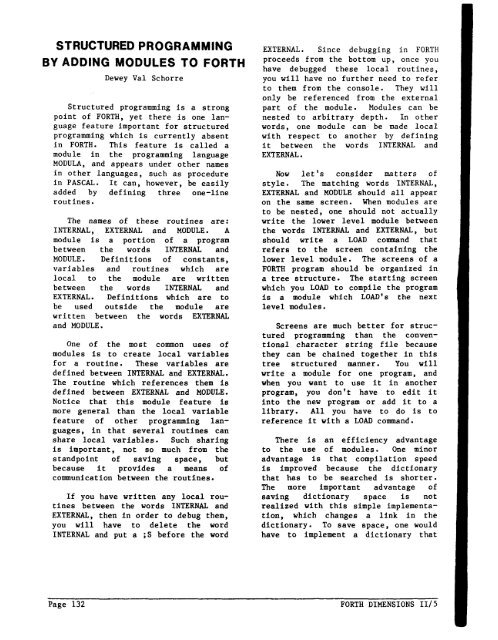5 - Forth Interest Group
5 - Forth Interest Group
5 - Forth Interest Group
Create successful ePaper yourself
Turn your PDF publications into a flip-book with our unique Google optimized e-Paper software.
STRUCTURED PROGRAM MlNG<br />
BY ADDING MODULES TO FORTH<br />
Dewey Val Schorre<br />
Structured programming is a strong<br />
point of FORTH, yet there is one lan-<br />
guage feature important for structured<br />
programming which is currently absent<br />
in FORTH. This feature is called a<br />
module in the programming language<br />
MODULA, and appears under other names<br />
in other languages, such as procedure<br />
in PASCAL. It can, however, be easily<br />
added by defining three one-line<br />
routines.<br />
The names of these routines are:<br />
INTERNAL, EXTERNAL and MODULE. A<br />
module is a portion of a program<br />
between the words INTERNAL and<br />
MODULE. Definitions of constants,<br />
variables and routines which are<br />
local to the module are written<br />
between the words INTERNAL and<br />
EXTERNAL. Definitions which are to<br />
be used outside the module are<br />
written between the words EXTERNAL<br />
and MODULE.<br />
One of the most common uses of<br />
modules is to create local variables<br />
for a routine. These variables are<br />
defined between INTERNAL and EXTERNAL.<br />
The routine which references them is<br />
defined between EXTERNAL and MODULE.<br />
Notice that this module feature is<br />
more general than the local variable<br />
feature of other programming lan-<br />
guages, in that several routines can<br />
share local variables. Such sharing<br />
is important, not so much from the<br />
standpoint of saving space, but<br />
because it provides a means of<br />
communication between the routines.<br />
If you have written any local rou-<br />
tines between the words INTERNAL and<br />
EXTERNAL, then in order to debug them,<br />
you will have to delete the word<br />
INTERNAL and put a ;S before the word<br />
Page 132<br />
EXTERNAL. Since debugging in FORTH<br />
proceeds from the bottom up, once you<br />
have debugged these local routines,<br />
you will have no further need to refer<br />
to them from the console. They will<br />
only be referenced from the external<br />
part of the module. Modules can be<br />
nested to arbitrary depth. In other<br />
words, one module can be made local<br />
with respect to another by defining<br />
it between the words INTERNAL and<br />
EXTERNAL.<br />
Now let's consider matters of<br />
style. The matching words INTERNAL,<br />
EXTERNAL and MODULE should all appear<br />
on the same screen. When modules are<br />
to be nested, one should not actually<br />
write the lower level module between<br />
the words INTERNAL and EXTERNAL, but<br />
should write a LOAD command that<br />
refers to the screen containing the<br />
lower level module. The screens of a<br />
FORTH program should be organized in<br />
a tree structure. The starting screen<br />
which you LOAD to compile the program<br />
is a module which LOAD'S the next<br />
level modules.<br />
Screens are much better for struc-<br />
tured programming than the conven-<br />
tional character string file because<br />
they can be chained together in this<br />
tree structured manner. You will<br />
write a module for one program, and<br />
when you want to use it in another<br />
program, you don't have to edit it<br />
into the new program or add it to a<br />
library. All you have to do is to<br />
reference it with a LOAD command.<br />
There is an efficiency advantage<br />
to the use of modules. One minor<br />
advantage is that compilation speed<br />
is improved because the dictionary<br />
that has to be searched is shorter.<br />
The more important advantage of<br />
saving dictionary space is not<br />
realized with this simple implementa-<br />
tion, which changes a link in the<br />
dictionary. To save space, one would<br />
have to implement a dictionary that<br />
FORTH DIMENSIONS 11/ 5
















